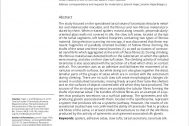Obsah
The study focused on the specialised tarsal setae of tarantulas Avicularia metallica and Heteroscodra maculata, and the fibrous and non-fibrous material produced by them. When irritated spiders moved along smooth, perpendicularly-oriented glass walls not covered in silk, the claw tuft setae, located at the tips of the tarsal segments, left behind footprints containing two types of fibrous material. Using electron scanning microscopy, it was discovered that these represent fragments of parallelly oriented bundles of hollow fibres forming the shafts of the setae and their lateral branches (1), as well as clusters of contracted nanofibrils which aggregated at the ends of these fibres (2). During climbing, this fibrous material was detected both on the substratum on which the spiders were moving, and also on their claw tuft setae. The climbing activity of irritated tarantulas is also associated with the secretion of a fluid which dries on contact with air. This secretion acts as an adhesive and facilitates the movement of tarantulas on smooth surfaces, but while doing so it also glues together the distal, lamellar parts of the groups of setae which are in contact with the substratum during climbing. There are no such claw tuft setae morphological changes observed in undisturbed tarantulas, moving freely around their tube-like shelters and on the surfaces of objects covered with silk which they have produced. The sources of the air-drying secretion are probably the tubular fibres forming the shafts of pretarsal setae. The bundles of hollow fibres are an example of a system that produces secretions via a surficial pathway. The spinnerets and silk-producing glands associated with them, located in the opisthosoma, represent a system that produces silk via a systemic pathway. However, the results of observational studies have not confirmed the ability of tarantulas’ feet to produce silk fibres of the same, or at least similar ultrastructure to that of the silk fibres produced by the activity of spinnerets and spinneret-associated silk glands.



